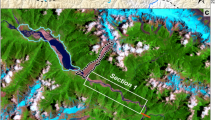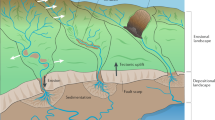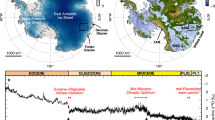Abstract
Landscapes on Earth retain a record of the tectonic, environmental and climatic history under which they formed. Landscapes tend towards an equilibrium in which rivers attain a stable grade that balances the tectonic production of elevation and with hillslopes that attain a gradient steep enough to transport material to river channels. Equilibrium low-relief surfaces are typically found at low elevations, graded to sea level. However, there are many examples of high-elevation, low-relief surfaces, often referred to as relict landscapes1,2, or as elevated peneplains3. These do not grade to sea level and are typically interpreted as uplifted old landscapes, preserving former, more moderate tectonic conditions4. Here we test this model of landscape evolution through digital topographic analysis of a set of purportedly relict landscapes on the southeastern margin of the Tibetan Plateau, one of the most geographically complex, climatically varied and biologically diverse regions of the world. We find that, in contrast to theory, the purported surfaces are not consistent with progressive establishment of a new, steeper, river grade, and therefore they cannot necessarily be interpreted as a remnant of an old, low relief surface. We propose an alternative model, supported by numerical experiments, in which tectonic deformation has disrupted the regional river network, leaving remnants of it isolated and starved of drainage area and thus unable to balance tectonic uplift. The implication is that the state of low relief with low erosion rate is developing in situ, rather than preserving past erosional conditions.
This is a preview of subscription content, access via your institution
Access options
Subscribe to this journal
Receive 51 print issues and online access
$199.00 per year
only $3.90 per issue
Buy this article
- Purchase on Springer Link
- Instant access to full article PDF
Prices may be subject to local taxes which are calculated during checkout



Similar content being viewed by others
References
Clark, M. K. et al. Use of a regional, relict landscape to measure vertical deformation of the eastern Tibetan Plateau. J. Geophys. Res. 111,http://dx.doi.org/10.1029/2005JF000294 (2006)
Schoenbohm, L. M., Whipple, K. X., Burchfiel, B. C. & Chen, L. Geomorphic constraints on surface uplift, exhumation, and plateau growth in the Red River region, Yunnan Province, China. Geol. Soc. Am. Bull. 116, 895–909 (2004)
Davis, W. Baselevel, grade and peneplain. J. Geol. 10, 77–111 (1902)
Babault, J., Van Den Driessche, J., Bonnet, S., Castelltort, S. & Crave, A. Origin of the highly elevated Pyrenean peneplain. Tectonics 24, TC2010 (2005)
Tapponnier, P., Peltzer, G., Le Dain, A., Armijo, R. & Cobbold, P. Propagating extrusion tectonics in Asia: new insights from simple experiments with plasticine. Geology 10, 611–616 (1982)
England, P. & Molnar, P. Right-lateral shear and rotation as the explanation for strike-slip faulting in eastern Tibet. Nature 344, 140–142 (1990)
Tapponnier, P. Oblique stepwise rise and growth of the Tibet Plateau. Science 294, 1671–1677 (2001)
Clark, M. K. & Royden, L. H. Topographic ooze: building the eastern margin of Tibet by lower crustal flow. Geology 28, 703–706 (2000)
Hallet, B. & Molnar, P. Distorted drainage basins as markers of crustal strain east of the Himalaya. J. Geophys. Res. Solid Earth 106, 13697–13709 (2001)
Burchfiel, B. C. & Chen, Z. Tectonics of the Southeastern Tibetan Plateau and its Adjacent Foreland 77–164 (Geological Society of America, 2012)
Clift, P. D., Blusztajn, J. & Nguyen, A. D. Large-scale drainage capture and surface uplift in eastern Tibet–SW China before 24 Ma inferred from sediments of the Hanoi Basin, Vietnam. Geophys. Res. Lett. 33,http://dx.doi.org/10.1029/2006GL027772 (2006)
Clark, M. K. et al. Surface uplift, tectonics, and erosion of eastern Tibet from large-scale drainage patterns. Tectonics 23,http://dx.doi.org/10.1029/2002TC001402 (2004)
England, P. & Houseman, G. Finite strain calculations of continental deformation. 2. Comparison with the India-Asia Collision Zone. J. Geophys. Res. 91, 3664–3676 (1986)
Rowley, D. B. & Currie, B. S. Palaeo-altimetry of the late Eocene to Miocene Lunpola basin, central Tibet. Nature 439, 677–681 (2006)
Hoke, G. D., Liu-Zeng, J., Hren, M. T., Wissink, G. K. & Garzione, C. N. Stable isotopes reveal high southeast Tibetan Plateau margin since the Paleogene. Earth Planet. Sci. Lett. 394, 270–278 (2014)
Henck, A. C., Huntington, K. W., Stone, J. O., Montgomery, D. R. & Hallet, B. Spatial controls on erosion in the Three Rivers region, southeastern Tibet and southwestern China. Earth Planet. Sci. Lett. 303, 71–83 (2011)
Ouimet, W. B., Whipple, K. X. & Granger, D. E. Beyond threshold hillslopes: Channel adjustment to base-level fall in tectonically active mountain ranges. Geology 37, 579–582 (2009)
Duvall, A. R., Clark, M. K., Avdeev, B., Farley, K. A. & Chen, Z. Widespread late Cenozoic increase in erosion rates across the interior of eastern Tibet constrained by detrital low-temperature thermochronometry. Tectonics 31, TC3014 (2012)
Wilson, C. J. L. & Fowler, A. P. Denudational response to surface uplift in east Tibet: evidence from apatite fission-track thermochronology. Geol. Soc. Am. Bull. 123, 1966–1987 (2011)
Clark, M. K. et al. Late Cenozoic uplift of southeastern Tibet. Geology 33, 525–528 (2005)
Willett, S. D., McCoy, S. W., Perron, J. T., Goren, L. & Chen, C. Y. Dynamic reorganization of river basins. Science 343,http://dx.doi.org/10.1126/science.1248765
Perron, J. T. & Royden, L. An integral approach to bedrock river profile analysis. Earth Surf. Process. Landf. 38, 570–576 (2012)
Royden, L. & Taylor Perron, J. Solutions of the stream power equation and application to the evolution of river longitudinal profiles. J. Geophys. Res. Earth Surf. 118, 497–518 (2013)
Ferrier, K. L., Huppert, K. L. & Perron, J. T. Climatic control of bedrock river incision. Nature 496, 206–209 (2013)
Whipple, K. X. & Tucker, G. E. Dynamics of the stream‐power river incision model: Implications for height limits of mountain ranges, landscape response timescales, and research needs. J. Geophys. Res. Solid Earth 104, 17661–17674 (1999)
Seidl, M. & Dietrich, W. The problem of channel erosion into bedrock. Catena Suppl. 23101–124 (1992)
Weissel, J. & Seidl, M. in Rivers over Rock: Fluvial Processes in Bedrock Channels (American Geophysical Union Geophysical Monograph Series Vol. 107) (eds Tinkler, K. J. & Wohl, E. E.) 189–206 (American Geophysical Union, 1998)
Sklar, L. & Dietrich, W. E. in Rivers over Rock: Fluvial Processes in Bedrock Channels (American Geophysical Union Geophysical Monograph Series Vol. 107) (eds Tinkler, K. J. & Wohl, E. E.) 237–260 (American Geophysical Union, 1998)
Goren, L., Willett, S. D., Herman, F. & Braun, J. Coupled numerical-analytical approach to landscape evolution modeling. Earth Surf. Process. Landf. 39, 522–545 (2014)
Liu-Zeng, J., Tapponnier, P., Gaudemer, Y. & Ding, L. Quantifying landscape differences across the Tibetan plateau: implications for topographic relief evolution. J. Geophys. Res. 113,http://dx.doi.org/10.1029/2007JF000897 (2008)
Jarvis, A., Reuter, H. I., Nelson, A. & Guevara, E. Hole-filled SRTM for the globe v. 4 (http://srtm.csi.cgiar.org/ csi. cgiar. org) (2008)
Bookhagen, B. & Strecker, M. R. Orographic barriers, high‐resolution TRMM rainfall, and relief variations along the eastern Andes. Geophys. Res. Lett. 35,http://dx.doi.org/10.1029/2007GL032011 (2008)
Xu, G. & Kamp, P. J. Tectonics and denudation adjacent to the Xianshuihe Fault, eastern Tibetan Plateau: constraints from fission track thermochronology. J. Geophys. Res. Solid Earth 105, 19231–19251 (2000)
Acknowledgements
We thank C.-Y. Chen for discussion and assistance with digital elevation model analysis. Reviews by D. Burbank improved the manuscript.
Author information
Authors and Affiliations
Contributions
S.D.W. conceived and directed the project. R.Y. analysed the topography and precipitation. R.Y. and L.G. constructed the numerical model. All authors contributed to interpretation and writing.
Corresponding author
Ethics declarations
Competing interests
The authors declare no competing financial interests.
Extended data figures and tables
Extended Data Figure 2 Yangtze, Salween and Mekong River χ-plots.
Plots are constructed using a range of m/n from 0.3 to 0.6 to test the variability of χ-profiles with concavity. The trunk rivers are highlighted in black. We use a value of 0.45 for the χ analysis, following the methodology described in ref. 21.
Extended Data Figure 3 River courses and χ-plots for the region of low-relief landscape LCJ3 in the Mekong drainage.
See Fig. 1 for location. a, Perspective view of the landscape. The low-relief surface is shaded and the courses of ten rivers are keyed by colour and number to the χ-plots in b. b, Graph of χ-plots for rivers shown in a. Inset shows same data, scaled to include the full Mekong. Red tributaries are primarily interior to the low-relief landscape; blue rivers drain the exterior. Bold black river is the trunk river with flow direction indicated by the white arrow. The yellow point in each frame shows the downstream point common to all rivers. Triangles indicate prominent inflections in profiles and their locations in a. Interior rivers (1, 2, 3) are all shifted towards lower erosion rates. Exterior rivers are all shifted towards higher erosion rates. Tributary 9 appears to include a recent headwater capture. The absence of common form to the χ-plots indicates no common uplift history. The independence of individual catchments suggests variance is due to changing catchment area.
Extended Data Figure 4 River courses and χ-plots for the region of low-relief landscape NJ2 in the Salween drainage.
See Fig. 1 for location. Figure format as in Extended Data Fig. 3. a, Perspective view of the landscape. The low-relief surface is shaded and the courses of ten rivers are keyed by colour and number to the χ-plots in b. b, Graph of χ-plots for rivers shown in a. This surface is arguably part of the Tibetan Plateau proper and χ-values are nearly as large as the trunk river. Interior rivers (1, 2, 3) are all shifted into the area-loss field, although they are arguably not significantly different from the main stem. Tributary 4 includes a recent capture. Tributaries 5–10 are shifted into the area-gain field. Tributaries 6 and 7 might include captured reaches. Numbers in parentheses are erosion rates derived from 10Be concentrations16 or from thermochronometry (in italics)18 and indicate a fivefold increase in erosion rate in exterior basin 8, relative to interior basins.
Extended Data Figure 5 River courses and χ-plots for the region of low-relief landscape CJ3 in the Yangtze drainage.
See Fig. 1 for location. Figure format as in Extended Data Fig. 3. a, Perspective view of the landscape. The low-relief surface is shaded and the courses of 15 rivers are keyed by colour and number to the χ-plots in b. b, Graph of χ-plots for rivers shown in a. Rivers 1–5 are shifted into the area-loss field, and may have been captured given their steep, common lower reach. Remaining rivers are either in equilibrium or are shifted into the area-gain field, although all rivers in this area have a lower reach steeper than the trunk of the Yangtze. Unique to this low-relief surface, we analysed tributaries with two, independent, common confluence points. Tributaries 11–15 have a common confluence independent of tributaries 1–10, so there is potential for different base level control on each set. In addition, this area is subject to anomalous uplift associated with the Gonga Shan massif33. These tributaries have been illustrated in grey in b. Numbers in parentheses are erosion rates derived from 10Be concentrations17 and indicate rates in the exterior draining rivers one to two orders of magnitude higher than in the interior. This is consistent with the difference in slope of the χ-plots and migration of the intervening divide.
Extended Data Figure 6 River courses and χ-plots for the region of low-relief landscape CJ8 in the Yangtze drainage.
See Fig. 1 for location. Figure format as in Extended Data Fig. 3. a, Perspective view of the landscape. The low-relief surface is shaded and the courses of 14 rivers are keyed by colour and number to the χ-plots in b. b, Graph of χ-plots for rivers shown in a. Rivers 1–5 are shifted into the area-loss field, but do not show evidence of recent capture. Remaining rivers are either in equilibrium or are shifted into the area-gain field.
Extended Data Figure 7 River courses and χ-plots for the region of low-relief landscape CJ10 in the Yangtze drainage.
See Fig. 1 for location. Figure format as in Extended Data Fig. 3. a, Perspective view of the landscape. The low-relief surface is shaded and the courses of 15 rivers are keyed by colour and number to the χ-plots in b. b, Graph of χ-plots for rivers shown in a. Rivers 1–3 are shifted into the area-loss field, and may have been captured given their steep, common lower reach. This interpretation would include rivers 4 and 5. Remaining rivers are either in equilibrium or are shifted into the area-gain field.
Extended Data Figure 8 River courses and χ-plots for the region of low-relief landscape CJ12 in the Yangtze drainage.
See Fig. 1 for location. Figure format as in Extended Data Fig. 3. a, Perspective view of the landscape. The low-relief surface is shaded and the courses of nine rivers are keyed by colour and number to the χ-plots in b. b, Graph of χ-plots for rivers shown in a. Rivers 1–5 are shifted into the area-loss field. Tributaries 2, 3 and 7 show evidence of recent capture. Tributaries 6, 8 and 9 are shifted into the area gain field.
Extended Data Figure 9 River courses and χ-plots for the region of low-relief landscape LCJ2 in the Mekong drainage.
See Fig. 1 for location. Figure format as in Extended Data Fig. 3. a, Perspective view of the landscape. The low-relief surface is shaded and the courses of nine rivers are keyed by colour and number to the χ-plots in b. b, Graph of χ-plots for rivers shown in a. Rivers 1 and 2 are shifted into the area-loss field. Tributaries 7 and 8 indicate recent capture. Tributaries 3–6 are shifted into the area-gain field. Numbers in parentheses are erosion rates derived from 10Be concentrations16 or from thermochronometry (in italics)19 and indicate rates much higher in exterior basin 9 relative to the interior.
Supplementary information
Landscape evolution model of continental indentation
Landscape evolution initiates from a near-steady state landscape, subjected to a horizontal strain rate field simulating indentation of rigid blocks. River network and erosion rate are mapped over domain as a function of time. See Methods for model details. Upper and lower halves of the model can be regarded as independent realizations of a corner indentation problem as proposed for the TRR. Note increase in erosion rate variance with large areas of low erosion rate generated and maintained by loss of drainage area. (MOV 27572 kb)
Rights and permissions
About this article
Cite this article
Yang, R., Willett, S. & Goren, L. In situ low-relief landscape formation as a result of river network disruption. Nature 520, 526–529 (2015). https://doi.org/10.1038/nature14354
Received:
Accepted:
Issue Date:
DOI: https://doi.org/10.1038/nature14354
This article is cited by
-
Seismites as an indicator of active faulting along the Moradabad Fault: A further study on neotectonics in the Indo-Gangetic plains
Journal of Earth System Science (2024)
-
Past rainfall-driven erosion on the Chinese loess plateau inferred from archaeological evidence from Wucheng City, Shanxi
Communications Earth & Environment (2023)
-
Exploring watershed structural variation during watershed evolution process under artificial rainfall experiment
Earth Science Informatics (2023)
-
Feedbacks between sea-floor spreading, trade winds and precipitation in the Southern Red Sea
Nature Communications (2022)
-
The methods and program implementation for river longitudinal profile analysis—RiverProAnalysis, a set of open-source functions based on the Matlab platform
Science China Earth Sciences (2022)
Comments
By submitting a comment you agree to abide by our Terms and Community Guidelines. If you find something abusive or that does not comply with our terms or guidelines please flag it as inappropriate.



